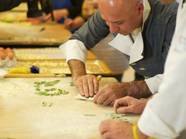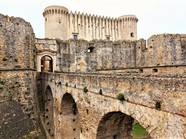Italian/American Cultural Philanthropy: What is cultural philanthropy and when will it come to Italian America?
Sunday morning I attended the first annual Italian American “Ambasciatori” Awards, which were presented to a series of Italian/American organizations in the greater New York area, including lower Connecticut. In all, I believe more than forty individuals representing forty institutions of all sorts were celebrated. Among the general public, there were, at a quick count, about 500 people present, since there were fifty-two tables numbered, that I could see, and an additional awardees table of about forty people.
The event was also, indeed primarily, a fund-raiser for the young Italian American Museum of New York, which has recently acquired property in Little Italy, at the corner of Mulberry and Grand Streets. Where else might we want to see an Italian/American museum housed, if not in Little Italy? I suspect there are those who might want to see it elsewhere, and I am sure there is a rational argument for so doing. Yet, I would submit, there are also excellent reasons for having it in Little Italy.
Location, however, is not my concern in this edition of my blog. Instead, I would like our readers to consider other things. First, while it is true that we have a couple of so-called “free-standing” museums in places like San Francisco and New Orleans, it is also fair to say, I believe, that these museums are, in some cases, dedicated ,to a certain degree, to the history of Italians in the local area. Second, these few existing museums tend to be limited in size of both venue and personnel, so (a) what they do, they can only do on a limited scale, and (b) because their staff is small, they must rely on volunteers. Third, in light of these initial two issues, where do Italian Americans stack up vis-à-vis other US ethnic groups? Does a similar situation exist, for example, with other ethnic groups? Do they, too, have a sampling of small museums around the country still in search of creating something larger?
These are, I know, rhetorical questions, and the answers are, I suspect, quite clear. Just about all other “historical” ethnic groups in the United States have not one but, for sure, several large, free-standing museums that preserve their past and, in so doing, impart that knowledge onto the newer generations, and, by natural progression, celebrate their present and future. We Italian Americans have yet to find (read, also, found) such a place in order to do so. As we enter deeper into the 21st century, less than two months shy of a new year (2008), and more than one hundred twenty-five years after the onset of the major wave of immigration from western Europe, we Italian Americans still have no major museum! This is, simply, unacceptable.
Education is the only way we can change people’s minds. The Italian/American community must step up to the plate and support grand projects such as an Italian/American museum or any other entity and/or institution dedicated to the imparting of knowledge of our history and culture. This, of course, brings me to the other areas I consider to be in dire need of cultural philanthropy that I mention in my abstract to this blog: namely, the lack of Italian/American names on (a) college and university libraries, (b) colleges of arts and humanities, and (c) named (read, privately endowed) professorships, just to name a few areas. And I cannot underscore the humanities aspect of this conversation of mine. The hard sciences and other fields such as business and economics seem to have fared quit well in many places. But in very few places, indeed, do we find the names of our ethnic brethren when we deal with areas such as the arts, the humanities, named professorships, and centers for Italian and/or Italian/American studies.
A handful of names, literally, comes to mind when I think of philanthropy vis-à-vis Italian and Italian/American studies: Charles and Joan Alberto endowed the Charles and Joan Alberto Italian Studies Institute (Seton Hall University); Joseph M. and Geraldine C. La Motta endowed the Joseph M. and Geraldine C. La Motta Chair in Italian Studies (Seton Hall University); The Valente Family’s funding of the The Valente Family Italian Studies Library (Seton Hall University) has set up a collection of Italian books second to none; the Baroness Mariuccia Zerilli-Marimò’s most generous donation funds in perpetuity the Casa Italiana Zerilli-Marimò, home of the Department of Italian Studies at New York University; Joseph and Elda Coccia have endowed The Joseph and Elda Coccia Institute for the Italian Experience in America (Montclair State University); and, dulcis in fundo, George L. Graziadio endowed the George L. Graziadio Center for Italian Studies and its George L. Graziadio Chair of Italian Studies at California State University in Long Beach.
While what I have listed above tends more toward Italian than Italian/American Studies, the majority of these programs does include Italian Americana as a valid field of intellectual inquiry under their respective umbrellas of Italian Studies. But these are just the beginning. Italian/American Studies has progressed magnificently over the past thirty years at the college and university levels. There are numerous programs or parts thereof at both the undergraduate and graduate levels nationwide. Indeed, for this to filter down to the public school system (where it is most needed in order to create future thinkers in this regard), access to Italian/American Studies for more graduate students needs greater facilitation. This, simply, will not happen through public funding alone. There needs to be a significant articulation between the academic world and those of Italian America who can readily underwrite any and all of the above-mentioned entities, centers and institutes. This includes also graduate fellowships so that those graduate students in, for example, history, sociology, literature, cinema, and the like, can dedicate themselves fulltime in graduate school to earning their degrees, and not be distracted by having to work part-time. Because many of us have had to follow this second path, it does not mean our children and grandchildren should do the same. Anzi!
It is a great challenge that lies ahead of us, but it is a feasible accomplishment, to be sure. The six above-mentioned centers and professorships are proof positive. We need to talk, and talk, and talk in order to do, and do, and do…
Alla riscossa!


































i-Italy
Facebook
Google+
This work may not be reproduced, in whole or in part, without prior written permission.
Questo lavoro non può essere riprodotto, in tutto o in parte, senza permesso scritto.